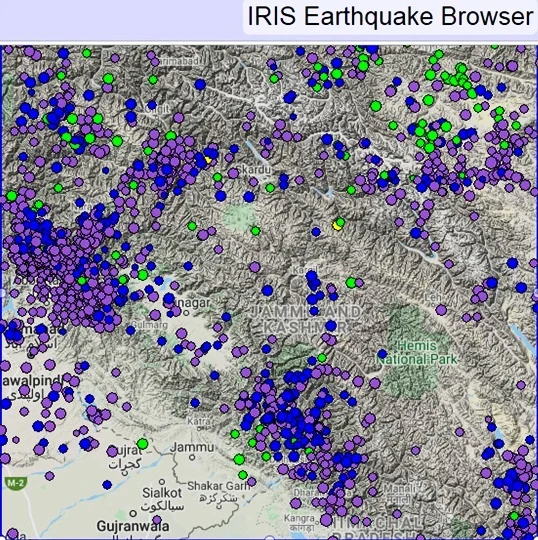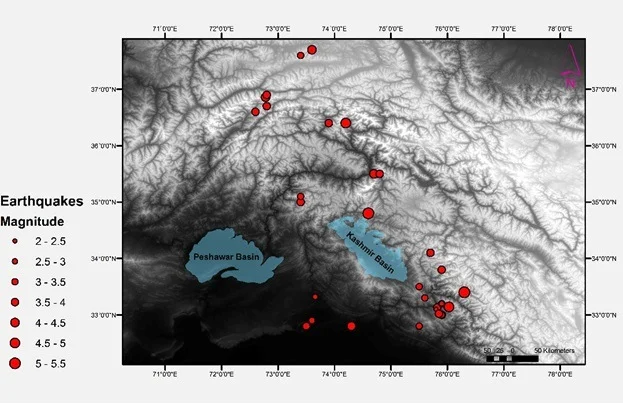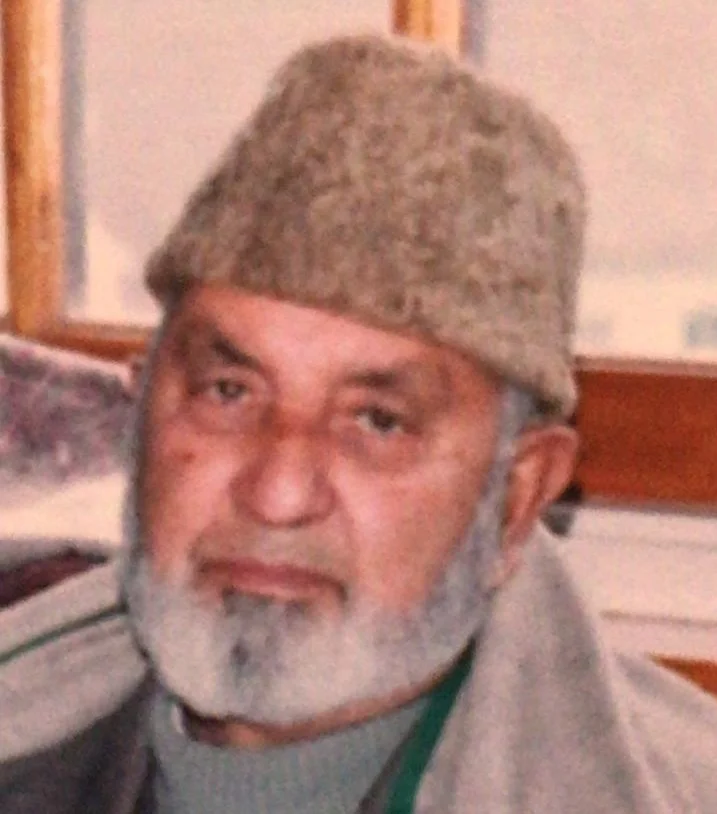
The picturesque landscape shaken by the 2005 earthquake has already witnessed around 40 low-intensity tremors since the start of the catastrophic year of 2020. The recurrent yet unruffled rattles are forcing experts to reveal that Kashmir Valley with petrified past isn’t ready to face any major shake at the present.
By Swati Joshi
JUST before the earthquake of 7.6 magnitude would wobble Kashmir in the rattling fall of 2005, Tufail Andrabi, 39, was casually conversing with his friends in his hometown Srinagar neighbourhood. But as ground beneath his feet shook, he saw his petrified family members and neighbours coming out of their houses by wringing their hands, beating their chests and praying with their quivering lips.
Many cried, some stood in what looked like a parting embrace, yet most hoped against the hope.
“Nobody slept that night,” Andrabi, now a software engineer, recalled the trembling day of his life. “Never in my life had I experienced as intense quake as I did that day. And those periodic aftershocks further freaked everyone in that agonized autumn.”
What surprised him that day were his downtown neighbourhood’s rundown structures.
“That day most of us thought that they would crumble like a pack of cards anytime soon and bury us alive,” Andrabi recounted the bygone horror with vivid details.
“But to everyone’s wonder, while some new concrete structures developed cracks, those old structures remain sturdy.”
Even today, as the low-intensity tremors are shaking the valley and reminding many of that devastating fall, those heritage structures are still standing their ground.
With grim reminder, many wonder: Has Kashmir learned its lessons fifteen years after the quake nightmare flattened the parts of frontier Kashmir—with northern Kashmir’s Kupwara and Baramulla boroughs bearing the major brunt?
As a firefight response, the then PDP-Congress coalition government decided to use earthquake-resistant materials for construction of buildings.
“But the effect was short-lived,” Saleem Beg, convener at Indian National Trust for Art and Cultural Heritage (INTACH), told Kashmir Observer.

People living in rural areas get permission from the village panchayat for any constructional activities, he said, as they don’t even know about earthquake-resistant material.
“Since Kashmir has faced a devastating earthquake in the past, it should be well-prepared but even basic minimum thing is not done since 2005,” Beg said.
Though the epicenter of the 8 October 2005 earthquake was Muzaffarabad, but it affected many parts of Kashmir.
Tangadhar in Kupwara and Uri in Baramulla were the worst affected towns in the valley.
According to the Earthquake Disaster Risk Index Report 2019, about 1500 deaths were reported and 4,50,000 building collapsed in Kashmir due to the 2005 earthquake.
The report blamed the “poor performance” of the masonry for the major devastation.
The report, however, credited Kashmir’s unique construction—Dhajji Diwari—for showing “very good seismic performance”.
An Earthquake Antidote
Dhajji Diwari is a conventional earthquake-resistant construction method in which timber frames are used for building structures. The spaces in the frame are filled by stones or bricks and plastered in mud mortar.
This 200-year-old construction technique got wide recognition after the 2005 Kashmir earthquake.
This traditional form of construction was safer due to the presence of “wood runners at each floor binding the walls together with the floors with no abrupt discontinuities or variations in stiffness in the diaphragms acting as seismic resistant structure” unlike the present form of construction which is weak, rigid and stiff, claims a study by researcher Maqbool Yusuf.

The study notes that since Kashmir has not faced an earthquake of large magnitude after 2005, the structures in the valley are unplanned, weak and unsafe, mostly constructed “without knowledge of future severe seismicity in this region”.
Kashmir’s present day infrastructure remains its Achilles heel.
“If it was dismal at that time [in 2005],” Saleem Beg asserted, “it’s catastrophic now!”
As the population of Kashmir has grown to about 7 million, the conventional structures in the valley are replaced by modern unscientific structures lacking quake immunity.
“A seven-storey hospital is constructed in Rajbagh,” Beg said. “It’s a prime residential area where there’s no space for an ambulance to take a turn. As such haphazard construction is happening in the valley, where’s the regulatory mechanism?”
Having suffered the massive jolts before, Beg said, the government should’ve implemented strict laws that prohibit the constructional activities which do not suffice to be earthquake resistant.
“Doing an awareness drive will not stop people from constructing their houses with modern unscientific techniques,” emphasized Beg. “Awareness is no alternative for law.”
He suggested that regulations make people aware and the government should be swift in employing a regulatory mechanism.
In order to understand the official preparedness, Kashmir Observer approached Disaster Management and other allied bodies. But the repeated attempts didn’t elucidate any response on the groundwork in wake of any major tremor in the valley.
Fatal Positioning
Kashmir lies in Seismic Zone V which is seismically the most active region where some of the powerful earthquakes have occurred in past.
Since January 2020, 37 minor earthquakes have hit the Jammu and Kashmir region, according to the data available on the website of the National Center of Seismology.
“The epicenters of these earthquakes are in the northwestern and southeastern sides of the valley,” said Dr. Afroz Ahmad Shah, Assistant Professor in Structural Geology at Universiti Brunei Darussalam.
Some of these earthquakes are most probably related to the local active faults, he said, and some have ruptured frontal portions at depth.
A fault is a fracture in the earth’s crust which is formed due to stress by the movements of the tectonic plates, the professor explained. This movement, he said, may occur rapidly, in the form of an earthquake.
“Since these are small quakes, therefore, it will be hard to know which part of the fault they have ruptured,” Dr. Shah said.
On being asked about the reason behind the recurring earthquakes in the valley, the young professor said that India is in collision with the Eurasian plate, which causes earthquakes.
“Kashmir is located at a point where the Indian plate meets the Eurasian plate,” he said.
“The collision between the plates has resulted in the formation of the Himalayas making the region prone to seismic activity. The movements of the plates create tremendous stress to build up along faults which sometimes results in earthquakes releasing the built-up stress.”
Amid the low-intensity jolts in the valley, people are skeptical that the recurring foreshocks—earthquakes which occur before the mainshock—may be a precursor to an earthquake of a bigger magnitude.
Explaining this, Dr. Shah said that previous studies have shown that some foreshocks may continue for years, and still, it’s not feasible to differentiate the mainshock from foreshocks.
“Not each earthquake comes with a warning shot, the foreshock,” he said. “Some major earthquakes have occurred without any foreshock at all.”
Calling such events as precursors to the main event is not correct, the professor stressed.

Looking at the earthquakes that have occurred from 1970 until now (as filled coloured circles show in above picture), most of the earthquakes have struck northeast and southwest portions of Kashmir region, explained Shah.
“This means that the earthquake does occur but differentiating foreshocks from mainshocks have always been a difficult task.”
Besides Kashmir, Delhi is also experiencing recurring tremors lately. On being asked about the similarity between the minor earthquakes in both the regions, Dr. Shah explained that the earthquakes in Delhi and Kashmir have occurred on two different fault systems.
“Delhi earthquakes have occurred in the Indian tectonic plates and away from the plate margin marked by the active Main Himalayan/Frontal Thrust (MHT/MFT),” he said.
MHT/MFT fault is the youngest and it also absorbs about half of the regional tectonic convergence between the Indian plate and southern Tibet which poses a severe earthquake hazard and risk to millions of people that live nearby, the professor explained.
On being asked about the proneness of Kashmir to earthquakes as compared to other regions falling in Seismic Zone V, Dr. Shah said that Kashmir is vulnerable to earthquakes, but to say it is more prone to earthquakes may be difficult to answer.
“This needs complete information on strain accumulation on faults, mapping of unknown faults, and how faults have ruptured in the past,” explained Dr. Shah.
But these details are largely missing.
The Himalayan geological fault system is considered the largest and the fastest slipping continental megathrust that traverses from Pakistan through India and Nepal, covering a distance of around 2500 km along the southern side of the Himalayan mountain range.
The entire extent of the fault is active and capable of producing major earthquakes but the timing remains uncertain, Dr. Shah continued.

“Seismic zonation maps change whenever new faults are discovered, so, I would not fully rely on such maps,” the professor said.
“Advanced and reliable seismic scenario maps are used in California where each fault is characterized.”
Clarifying the nature of the faults, Dr. Shah said that faults work as a family where each member behaves differently, and to understand the faults better, the entire family system has to be understood.
“Kashmir is still at a very juvenile stage of earthquake research and we have to work hard to match the standards of California or Japan,” the professor said.
However, according to various studies the risk of earthquake in Kashmir is real, and the region could be hit by a major earthquake in the future.
“But one can’t predict it’s accurate timing,” Dr. Shah said.
“The best remedy is to prepare for any eventuality. But unfortunately, there are no preparations on the ground.”
Follow this link to join our WhatsApp group: Join Now
Be Part of Quality Journalism |
Quality journalism takes a lot of time, money and hard work to produce and despite all the hardships we still do it. Our reporters and editors are working overtime in Kashmir and beyond to cover what you care about, break big stories, and expose injustices that can change lives. Today more people are reading Kashmir Observer than ever, but only a handful are paying while advertising revenues are falling fast. |
| ACT NOW |
| MONTHLY | Rs 100 | |
| YEARLY | Rs 1000 | |
| LIFETIME | Rs 10000 | |











